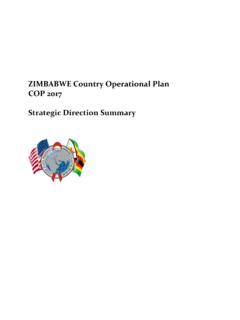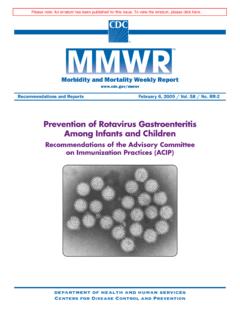Transcription of Recommendations on the Use of PrEP for All …
1 Recommendations on the Use of PrEP for All Populations pepfar scientific advisory board (SAB) Submitted by the PrEP Expert Working Group (EWG) to the SAB Approved by the SAB on October 14, 2015 Members of the PrEP EWG Dr. Quarraisha Abdool Karim, Co-chair Dr. Jared Baeten Dr. Connie Celum, Chair Dr. Robert Grant Dr. Nina Hasen Dr. Colleen Kelley Dr. Fabio Mesquita Dr. Helen Rees Dr. Heidi Van Rooyen Mr. Mitchell Warren Representatives from the Office of the Global AIDS Coordinator (S/GAC), Department of State Dr. Maureen Goodenow Dr. Julia MacKenzie Dr. Douglas Shaffer Broad Objectives of the PrEP EWG: To formulate Recommendations for the pepfar scientific advisory board s consideration on the prioritization, support and logistics of implementing pepfar -funded pre-exposure prophylaxis (PrEP). Process Overview: These Recommendations are based on four teleconferences and email correspondence that included members of the PrEP EWG and representatives from S/GAC. The PrEP EWG reviewed existing peer reviewed documents, unpublished reports and systematic reviews.
2 Special thanks and acknowledgement to: Rachel Baggaley and Meg Doherty from the World Health Organization (WHO), as well as EWG members Bob Grant and Jared Baeten for access to documents that were not yet in the public domain. Thanks also to S/GAC representatives and secretariat support for access to documents related to drug access, and the pepfar DREAMS initiative. Summary of PrEP Efficacy, Adherence and Implementation PrEP with oral tenofovir (TDF) or TDF co-formulated with emtricitabine (TDF/FTC) demonstrated substantial HIV prevention benefits (up to 75% reduction in HIV incidence) in trials conducted among men who have sex with men (MSM); people who inject drugs (PWID) in Thailand; HIV serodiscordant couples in Kenya and Uganda; and young men and women in Botswana. Subgroup analyses estimated efficacy to be very high (range from 80-92%) among those who had tenofovir in their blood samples. PrEP efficacy among women was high (approximately 70% compared to placebo and ~90% when tenofovir was detected in blood) in the Partners PrEP Study, including among younger women.
3 In contrast, in the oral PrEP efficacy trials (VOICE and FEM-PrEP) and daily and peri-coital tenofovir gel efficacy trials ( VOICE and FACTS, respectively) among young PrEP Recommendations 2 African women, efficacy was not demonstrated due to low levels of adherence to study product by study participants. Qualitative research during and after the VOICE and FEM-PrEP trials identified a number of factors that influenced the low use of PrEP, many of which were specific to the context of placebo-controlled clinical trials. These factors included motivations to take part in trials for access to quality health services, monetary reimbursement for study visits, monthly reminders that they may be in a placebo arm and not receiving active product, and that the active product had not been determined to be effective. Gender and power dynamics, and poor perception of their HIV risk also undermined PrEP use and could be factors during implementation in clinical practice as well.
4 The overall body of evidence for TDF-based oral PrEP is that it is a proven intervention that persons can use during periods of HIV risk, such as related to having a partner of unknown HIV status, unprotected sex when trying to conceive, with casual partners or when in an early stage of a relationship, and when they are unable to negotiate or utilize condoms, in settings with high HIV incidence rates. For HIV serodiscordant couples, PrEP provides the couple a way to achieve safer conception and protection for the HIV-uninfected partner until the HIV-infected partner initiates ART and is virally-suppressed. PrEP is also an additional option for HIV prevention for young women, MSM, PWID and sex worker populations. PrEP in the form of one pill a day is an intervention that can be used discreetly and independently and has the potential to significantly reduce HIV acquisition at an individual and population level. Open label studies undertaken to date either as demonstration projects, post-trial access or standard of care consistently highlight that if individuals, including young people, know that PrEP works, they are more likely to use it and be adherent.
5 Moreover, these projects have found that uptake is higher in those who self-identify as at HIV risk. Thus, with strong evidence for the efficacy and effectiveness of daily oral PrEP across multiple studies, it is a public health priority for pepfar to make PrEP available in high HIV prevalence settings in a strategic fashion to people at substantial risk, including adolescent girls and young women, HIV serodiscordant couples, female sex workers, men who have sex with men, and injection drug users, based on their risk. In order not to duplicate already available information, the EWG drew on several key documents. Most important and critical was an extensive and comprehensive systematic review undertaken by WHO in preparation for the recently released WHO ARV guidelines, which provides compelling evidence for TDF-based PrEP provision for all populations at high risk (provisionally defined as having an incidence rate of 3/100 p-y of follow-up on a population and geographic basis) of acquiring HIV and has been included in the recently released revised WHO ARV guidelines.
6 WHO PrEP Recommendations released on September 30, 2015 make a Strong, High-quality recommendation that Oral PrEP (containing TDF) should be offered as an additional prevention choice for people at substantial risk of HIV infection as part of combination prevention approaches . WHO is planning to release implementation guidance providing more specific operational guidance early in 2016. This guidance based on best available data was also utilized to specifically guide Recommendations on drug choices, safety monitoring, principles of adherence support, and use of PrEP during pregnancy outlined below. PrEP Recommendations 3 Recommendations for Targeting PrEP within pepfar 1. Prioritize PrEP for young women geographically in the 10 pepfar DREAMS countries, for counties and provinces with high HIV prevalence and incidence Over 50% of all new HIV infections taking place globally occur in the 10 pepfar countries prioritized for the DREAMS initiative. The high HIV incidence among young African women persists in spite of scale up of HIV testing, antiretroviral treatment as prevention and voluntary medical male circumcision.
7 One of the core pepfar targets for 2017 is to reduce incident HIV infections in young women aged 15-24 years by 40% with an initial reduction of 25% in 2016 through the pepfar DREAMS initiative. A core strategy for reaching this target reduction in HIV incidence in DREAMS is PrEP included within the context of a broader combination prevention approach. The strengthening of efforts to engage men in HIV prevention efforts and encouraging men to know their HIV status and be initiated on ARV treatment if infected, or undergo VMMC (if virally suppressed or HIV uninfected) and use available prevention options consistently, will indirectly impact HIV risk reduction in young women. a) The PrEP EWG recommends prioritizing PrEP for young women (15-24 years), who contribute a disproportionate number (one third) of all new HIV infections in eastern and southern Africa, which is more than four times that of their male peers. HIV risk in young women is driven by social, behavioral and biological vulnerability, which amplify each other.
8 Young women who are most likely to acquire infection are typically from socio-economically deprived households within high HIV prevalence communities, have limited or no schooling, engage in transactional sex or other high risk coping behaviors, and have histories of sexually transmitted infections and/or pregnancy. b) It is essential to offer young African women oral PrEP and support adherence in the context of clear, positive messaging and integration with delivery of other services that meet young women s needs ( , HIV testing, fertility control services that include family planning, emergency contraception, termination of pregnancy where legal, screening and treatment of sexually transmitted infections, pre-natal care, post-exposure prophylaxis, social support and referrals if there is intimate partner violence, and occupational skills training). Other longer acting PrEP formulations ( , monthly vaginal rings and long acting injectable agents which may be dispensed every two or three months) are in clinical development and do not yet have demonstrated efficacy.
9 If shown to be effective, these products may have higher uptake, acceptability and adherence than daily pill-taking. For now, daily oral TDF-based regimens are the only available evidence-based HIV prevention option for young women at high risk of acquiring HIV infection who have limited agency to negotiate the ABCC safer sex practices with their sexual partner(s). c) There are several steps that governments, donors and healthcare workers can take to directly improve outcomes for this key population at the individual level that can impact current epidemic trajectories in the region. These steps include being able to identify high HIV-risk young women and to offer acceptable HIV testing services and interventions as appropriate, including social support grants when available, access to schooling, non- PrEP Recommendations 4 judgmental counseling on sexual and reproductive health and relationships, gender-based violence counseling and referrals, mental health and substance abuse screening, contraceptive and pregnancy service provision, termination of pregnancy service provision where legal, screening and treating sexually transmitted infections, providing access to PrEP and to antiretroviral treatment for HIV positive young women, and delivering these services in the context of accessible youth-friendly services.
10 Novel approaches to enable availability and access to services should be supported in schools and through mobile services and adjusting clinic hours to accommodate employed and/or young women in school. d) In settings where PrEP is not accessible or available and/or no PrEP policy is in place, demonstration projects and studies of the operational aspects of PrEP implementation in diverse settings should inform policy and programmatic scale-up of PrEP in all populations and particularly for young women and adolescent girls. e) Early adopters of PrEP in young women could serve as peer recruiters, key informants and adherence supporters for other young women and/or their sexual partners for diffusion of the intervention into this key population and sexual networks. Thus, targets and metrics for PrEP implementation should be identified by pepfar in conjunction with the DREAMS countries. 100% of DREAMS countries should have PrEP delivery in 2016 with a geographic prioritization of delivery to counties, provinces or districts with the highest HIV prevalence and incidence among young women.

















